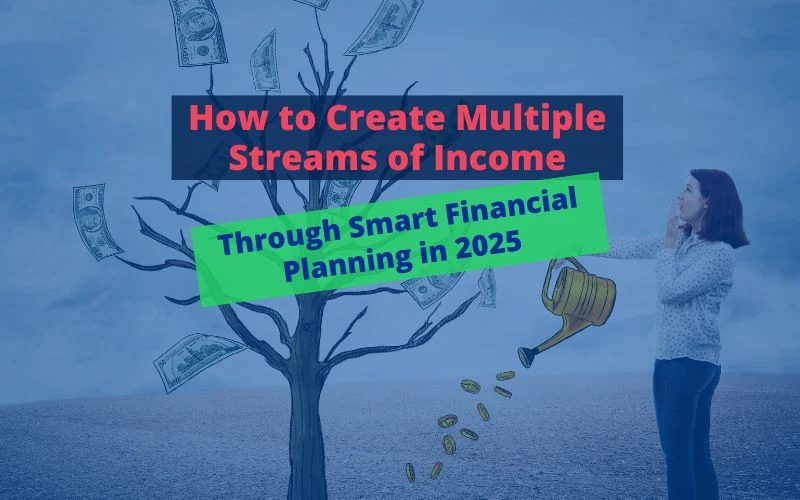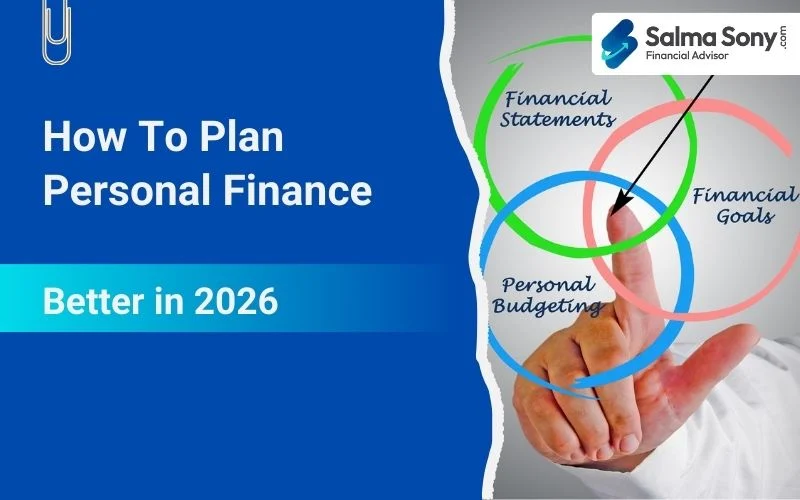Imagine sipping your coffee on a Tuesday morning, knowing your bank account grew overnight—without you lifting a finger. Sounds like a dream, right? That’s the power of knowing how to create multiple streams of income. That’s not just wishful thinking; it’s what happens when your money works for you in more ways than one.
Relying on just one income is no longer enough. A single job, no matter how stable, can leave you financially vulnerable when life throws the unexpected your way. That’s why more people are exploring smart ways to diversify their income sources and take control of their financial future.
The problem is that creating multiple revenue streams isn’t about working harder or taking on more work. It all comes down to working more efficiently and matching your revenue streams to your long-term financial objective. As a fee-only financial advisor, I have helped numerous clients create Smart Financial Planning since 2015 and navigate the way to generate passive income through their investment portfolios. In this blog, I will help you explore how to do the same.

Key Takeaways
- The money you earn without actively and consistently working for it is known as passive income.
- Relying on a single income stream can leave you financially exposed. Diversification is key to long-term stability.
- Multiple income streams can fast-track your goals, from paying off debt to building wealth and retiring early. But it takes time to build an effective income.
- A fee-only financial advisor helps you create a personalized financial plan aligned with your goals- without pushing products or earning commissions.
Benefits of Creating Multiple Sources of Income in 2025
1. Strengthens Financial Stability
Having more than one source of income can help you maintain stability in times of difficulty. Having an emergency fund is the first step towards it, and diversifying your income enables you to become less dependent on any one client or employer. During recessions or unanticipated life events like job losses, medical crises, or market crashes, this stability becomes even more valuable as emergency funds may last for a limited number of months. I strongly suggest having at least 6 months of emergency funds for salaried professionals and a year for business professionals.
2. Accelerates Wealth-Building
Extra income means more opportunities to save, invest, and grow your wealth. Additional income streams can continuously support your investment plans rather than waiting for bonuses or yearly raises. Your path to financial independence will be accelerated whether you invest those funds in long-term retirement plans, stocks, mutual funds, or bonds.
Suggested Reads: How To Attain Financial Freedom | 11 Steps to Achieve Financial Freedom
3. Supports Timely Debt Payments
When you are not reliant on a single paycheck, managing credit repayments and EMIs is less complicated. Secondary incomes give you breathing room, especially if your primary income option is down. It also helps to maintain a healthy credit score by lowering the likelihood of missed payments during economic downturns.
Related: Smart Debt Management Strategies to Regain Control of Your Finances
4. Provides a Safety Net During Emergencies
Life is full of unforeseen challenges. A medical crisis or unexpected loss of a job can put you in a difficult situation. By creating emergency funds and medical provision funds apart from having a medical insurance policy, you can be secured. However, in case of shortage, you won’t have to rush into high-interest loans or liquidate long-term investments if you have established income cushions through side gigs, dividends, or rentals.
5. Fast-Tracks Your Financial Goals
Do you want to retire early, travel the world, or buy a home? Having several streams of passive income can accelerate those financial goals. Having additional revenue allows you to accomplish short-term objectives without sacrificing long-term ones. And you can balance both if you plan ahead.
6. Encourages Skill Development and New Opportunities
Learning a new tool, business model, or investment strategy is often required when creating new revenue streams. In addition to keeping you sharp, this ongoing learning can lead to potential full-time transitions or diverse hobbies and passions.
When to Say NO- Income streams that Sounds Good but Doesn’t Fit Your Plan
Here’s a less-talked-about truth: not all income opportunities are worth your time. In fact, some can slow you down.
1. The side Income that Drains More than they Deliver
Some side projects require a lot of work but pay very little. Your primary financial objectives may be compromised if a project takes up your weekends and mental energy but only generates a small amount of revenue, particularly if it has an adverse effect on your family life or health. A healthy source of income should add to your life rather than drain it.
2. Over-leveraging the rental properties
Investing in real estate can be a great way to generate income, but it also comes with a lot of risk. Taking on too much debt or buying properties on EMIs without reliable rental income can lead to cash flow problems. While the property is unoccupied, you might have to pay the EMIs out of pocket, which would cause stress rather than adding to your passive income stream. Hence, don’t hurry up on taking property to generate rental income; instead, plan well and save enough to buy the property without a loan, which can, in a true sense, become your passive income.
How a Fee-only Financial Advisor will Help you Avoid these Traps?
As a fee-only advisor, my role is to offer unbiased guidance that prioritizes your best interest—not products or commissions. Here’s how working with a professional can help:
- Objective Evaluation: To assist in identifying revenue streams that complement your plan, I evaluate your financial profile, lifestyle, risk tolerance, and objectives.
- Cash Flow Planning: I ensure that your business activities or investments don’t leave you overly dependent on loans.
- Tax Strategy Support: To prevent you from losing a significant portion of your income to unforeseen liabilities, I analyze the tax implications of each form of income.
- Portfolio Management: I help you create and manage a mix of income sources that match your goals, lifestyle, and risk level—so every stream supports your bigger financial picture. I help reduce risk and increase long-term stability by diversifying your portfolio across multiple investments to create an income stream for your financial freedom.
- Accountability: Your financial strategy will remain on course even as your life changes if you have a fee-only financial planner by your side.
Want to make your money dreams come true?
A thoughtful, tailored financial plan is the first step toward turning your income into lasting wealth. As a fee-only financial planner, I assist you in defining what “enough” actually looks like for your lifestyle – and create a clear, sustainable strategy to get there.
Suggested Reads: A Good Financial Plan Can Make Your Money Dreams Come True! Let’s Plan 2025
FAST FACTS
Fee-only advice adoption is growing fastest among salaried professionals aged 30–45, especially in IT, finance, and healthcare – these individuals value trust, customization, and long-term wealth building over product pushing.
Questions to consider before selecting an Income stream or adding a new Income Stream
Before you dive into that additional income, ask yourself:
- Is this aligned with my long-term goals?
- Will this income be active or passive? How much time will it require?
- What are the upfront and ongoing costs?
- What is the risk vs. reward?
- How will this impact my taxes and cash flow?
- Do I need professional guidance to get started?
These questions help you avoid distractions and stay focused on sustainable growth.
How many income streams should you have?
When it comes to creating revenue streams, there is no “one size fits all” solution. Your current financial situation and the financial goals you have for the future should determine how many sources of income you have. However, having a few is a good place to start.
To take the first step towards creating purposeful wealth creation, download this; it will bring clarity to your financial goals, help you choose the right investments, and keep you motivated with measurable progress.
Rental properties, income-producing securities, and businesses are excellent ways to diversify your income stream in addition to the earned income from your human capital.
Ensure each income source complements your lifestyle and doesn’t distract from your long-term objectives. As a result, you must find a balance between your efforts and ensure that you are pursuing the most effective opportunities.
FAST FACTS
Only 24% of Indians have a structured financial plan – A majority rely on informal advice or short-term fixes rather than long-term planning.
Bottom Line
If you are looking for passive income opportunities and wondering how to create multiple streams of income in India, the smartest move you can make is to align them with your long-term financial goals. Whether you are trying to make a little extra money each month or are running a side business, passive income can be a great way to help you generate additional cash flow.
Related: Money Management Formula: Step-by-Step Guide for Budgeting
Keep in mind it’s not a matter of doing everything simultaneously but of building wisely, step by step. Prioritize income streams that deliver value without sacrificing your peace of mind. When uncertain, consult a fee-only financial advisor who can assist you in staying focused, organized, and on track with what matters most to you.
Multiple income streams are not just a trend but a long-term strategy for freedom, flexibility, and financial peace. Start with one, make it sustainable, and keep building from there.
FAQs
Q-1 What are the five types of income?
The five common types of income are: 1. Salary Income: Monthly salary from a corporate job, Bonuses or commissions, etc. 2. Rental Income: Monthly rent received from a tenant, Commercial property rent, Rental from machinery or equipment. 3. Business Income: Profits from freelancing or consultancy, sales from e-commerce business, income from a jewelry store you own. 4. Capital Gain Income: Selling land or property at a higher rate than purchase cost, sale of gold, art, or any vintage collection, profit from selling stocks. 5. Other Income: Interest income from savings accounts, fixed deposits, or bonds, income from lottery wins, dividend income from shares
Q-2 Does passive income really mean ‘no work’?
Not really. Most ideas to make extra money require some effort upfront—like time, research, or capital. But the goal is to reduce your involvement over time and create a predictable income that flows with little day-to-day effort. Example: Creating a valuable digital asset like YouTube videos, Vlog channel, Blog writing, etc.
Q-3 How long does it take to build reliable income streams?
It requires time, patience, and persistence. Certain streams of income—such as investments—will take years to come to fruition. Others—such as side hustles or service businesses—could potentially help you start earning within a few weeks or months.
Q-4 Can I start building multiple streams with a full-time job?
Absolutely. Many people start a side business or passive income stream while working full-time. The trick is to select something that is manageable and will not burn you out. Even a few hours a week can pay off in the long run.
Q-5 What’s the easiest way to earn passive income in 2025?
There isn’t a one-size-fits-all solution, but some of the most common means of passive income include investing in mutual funds or dividend-paying stocks. You can also consider royalties, digital products, or rental income—just be sure that any stream is compatible with your financial objectives.
Q-6 Is rental income a steady income stream, or does it come with risks?
Rentals can provide a consistent income stream—but only when managed well. Substantial maintenance expenses, tenant turnover, and property vacancies can undermine cash flow. Over-leveraging property with EMIs is risky if the property remains vacant for extended periods.
Q-7 Why is it important to earn money from multiple income sources instead of relying on just one?
When you earn money from multiple sources, you establish a financial cushion that will ensure you stay afloat when times get challenging. This diversified approach allows you to maintain your lifestyle and continue working toward your long-term goals, even when one income source is temporarily down.
Q-8 How does a financial advisor help create multiple income sources for retirees?
A fee-only financial advisor helps you design a strategy to generate income at your retirement by strategizing your existing investment portfolio, while ensuring each source aligns with your lifestyle and risk appetite. From evaluating existing investments to helping you leverage tax benefits, they give unbiased advice that maintains your income plan, making it sustainable and balanced. With their support, you can confidently earn money from a diverse investment portfolio without overreaching yourself or risking something unnecessary.
Q-9 How can side incomes support my long-term financial goals?
Side incomes provide additional funds that may be invested long-term in something such as a retirement plan, mutual funds, or real estate. Rather than just expecting annual bonuses or raises, you may also utilize this steady stream of money to accelerate goals such as early retirement, home ownership, or paying for your child’s education. It enables you to satisfy short-term requirements without having to sacrifice greater financial goals.
Q-10 Are all income opportunities worth pursuing?
Not necessarily. Certain income sources may seem appealing but will take up your time, energy, or money. For example, a part-time job with lengthy working hours but minimal returns may interfere with your primary job, personal time, or even your well-being. Likewise, over-investing in real estate without stable rental income can create a cash flow crunch. It’s vital to assess whether an opportunity truly adds value to your financial life.





